Peter, Brandon, and Jacob recently completed a commercial bird netting and clean-up job in Columbia. Pigeons had been roosting in the rafters above this utility building for quite some time, creating a mess. The guys were able to remove the nesting material, clean up the droppings, and install a netting to prevent further roosting.
Pigeon Nest Removal and Clean-Up
Our crew recently resolved a pigeon issue that a commercial building had been trying to handle for quite some time. Our expertly trained technicians were able to hand-craft everything needed for this unique job, and the birds haven’t been back since! If you have birds nesting in your signage or making a mess in front of your commercial or residential building, we would love to help resolve this for you!
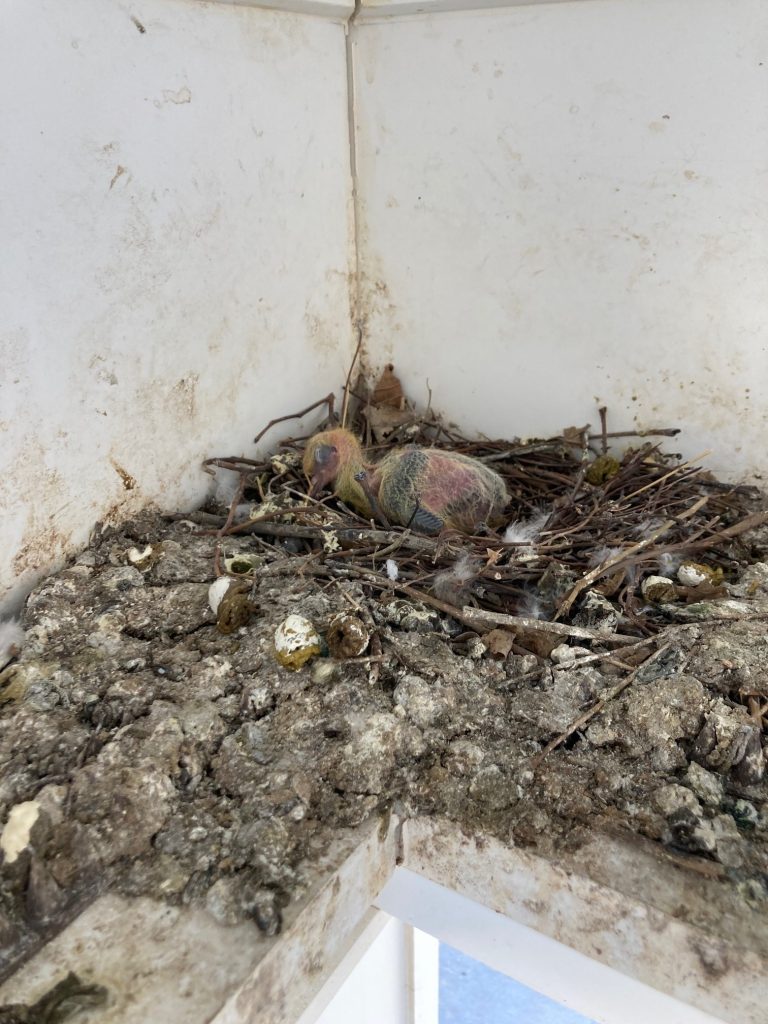
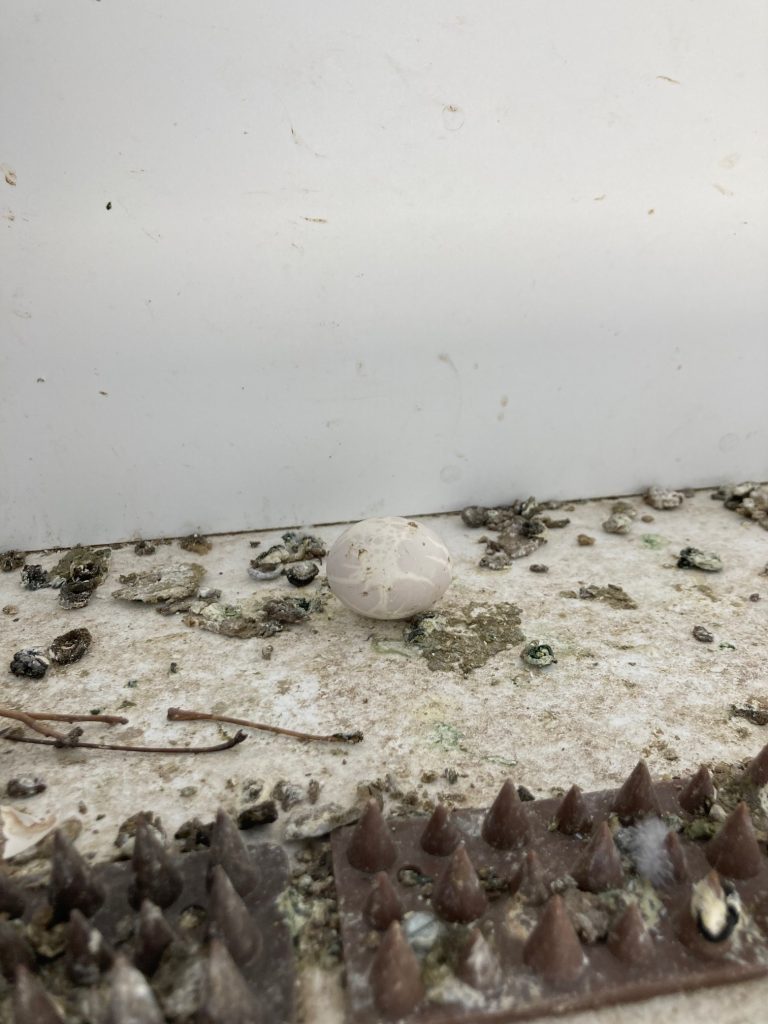
Bird Netting for Pigeon Control
Pigeons are common residents of industrial facilities, which provide countless roosting and nesting areas for the birds. Many of the high ledges and nooks pigeons prefer are inaccessible to people, but – even high up – the birds create a hazard because their droppings often fall onto walkways and work surfaces below.

Commercial Bird Control Services in Columbia, MO
Laws, regulations, and public sentiment afford birds considerable protection. Unwanted birds can damage your property and introduce health risks to your customers and employees.
Common pest bird problems for commercial properties include:
- Feeding on agricultural products
- Roosting or nesting around human habitations
- Destroying vegetation and contaminating foods
- Noise, droppings, odor and feathers
- Diseases or ectoparasites affecting man including histoplasmosis and cryptococcosis
- Unpleasant or hazardous working conditions
Our bird control services emphasize deterrents, exclusion, or modification of buildings. Critter Control’s knowledgeable technicians have bird-proofing and bird control methods for any nuisance bird situation – especially to get rid of birds that congregate on municipal and commercial buildings.
Why are the birds here? It is always about resources. For birds, as with other animals, their activities at any point in time are related to securing resources for survival. We must expand the standard needs list of “food, water, and shelter” when considering migration, breeding seasons, weather seasons, etc. Transitions between resources are also a major factor.
Parking lots can be a big attractant to birds and receive a lot of attention from the public who frequent these spaces. A typical parking lot scene includes the hard driving/parking surface, landscaped curbing, light poles, signs, trees, and retention ponds. Additionally, adjacent building’s rooftops and facades should be considered part of the immediate parking lot environment.
Each of these features can play a role in the species of birds attracted to the space.
The Most Common Birds in Parking Lots
Common bird species which infest parking lots in larger numbers include:
- Seagulls
- Geese
- Pigeons
- Grackles
- Crows
Seagulls are usually on site either in search of the food dropped by people or utilizing the building rooftops as a secure nesting surface.
Large numbers of geese are usually seasonal flocks congregating in and around parking lot retention ponds. Some geese are considered residents who do not migrate, and they are commonly found nesting in landscaping by entry doors and sometimes on rooftops.
Pigeons are resident birds and unlike most other bird species, pigeons will breed multiple times throughout the year. They will be found on the parking lot surface scavenging for food and taking advantage of signage, building facades and rooftop, which offer roosting and nesting opportunities.
Great-tailed grackles and crows are often only noticed when in larger flocks but will show up like clockwork each year as they migrate. They may stay on the site for a few days or weeks and can number in the thousands. They favor the taller trees, light fixtures, and signage in parking lots as nighttime roosting areas, though will hang out during daytime hours if close to food.
What Causes Bird Problems in a Parking Lot?
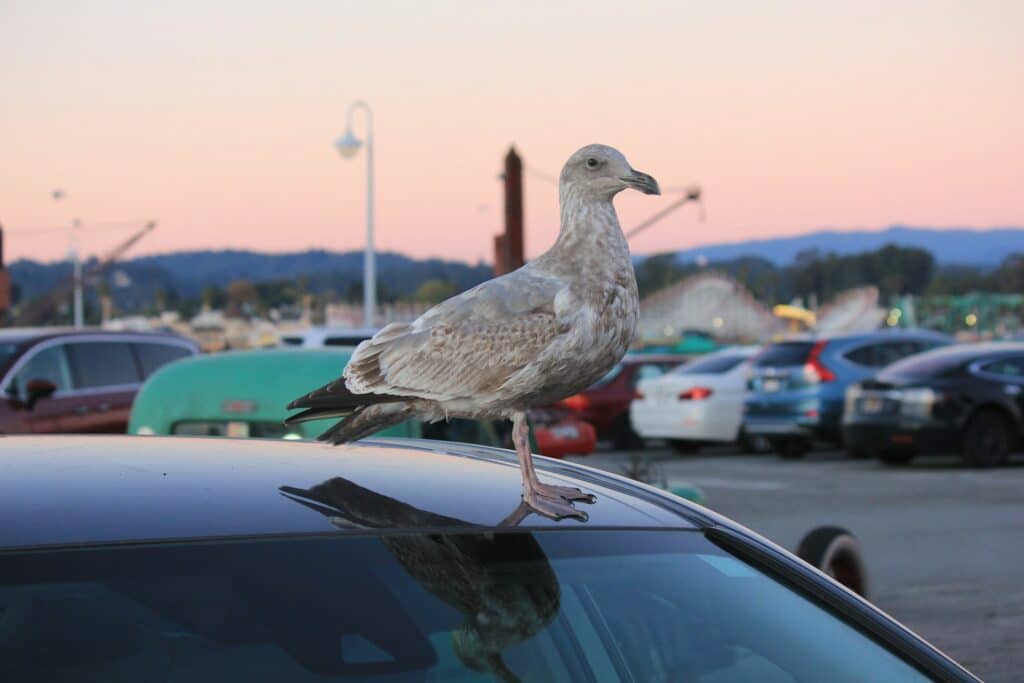
Destruction of habitat, or rather development of land, is regularly the scapegoat for new bird problems. This may be the case at times. More often, we see bird populations increase as the human population in an area increases. Birds are highly adaptable and use our man-made structures and unnatural agriculture practices to their advantage.
In our grand human fashion, we spend a lot of time and money attempting to solve the problems we cause, and bird infestations are no exception. We tend to act responsively to bird problems, though we are seeing a growing interest in proactive bird management investments with both new construction builds and existing properties.
Bird Control in Parking Lots

Since most birds (except pigeons, starlings, and sparrows) are protected under the Migratory Bird Treaty Act, methods to control these pest infestations are limited. Within the parking lot environment, the most successful control measures are more related to the area we are attempting to control the birds versus the type of birds.
For instance, when birds are roosting on the light poles in a parking lot, special bird deterrent cones can be fabricated to deny all bird species the ability to land there. Same goes for on top of signs and ledges on buildings. Bird electric track is a good low-profile option that can be powered with standard 110-volt electrical outlets or a solar panel with a battery. No bird species will tolerate electric sensations delivered by the bird track. Other non-electric options to minimize bird activity on elevated surfaces are bird wire (a post and spring-tensioned wire system) and gel discs (multi-sensory deterrent). In general, installation is simple, though it regularly requires the use of boom and scissor lifts.
Lasers for Large Flocks of Birds
Bird flocks roosting in the landscaping trees or nesting on the rooftops are more challenging (recent news of hundreds of birds in a Texas parking lot). The scheduled use of a powerful bird deterrent laser has proven successful in many bird situations where more traditional deterrent methods were unrealistic to install or there is a need to keep the birds off expansive spaces. These bird deterrent programs can be designed around handheld lasers, which require man-hours to operate, or automated laser systems. Each has pros and cons to be considered for the specific site.
Bird Control on the Ground
When pest birds are on the ground, and in the case of parking lots, this means on the driving surface or the landscaping, only the most restricted bird control methods can be employed. At this level, we must consider the interaction with people. Customers, employees, vendors, etc., will all “get in the way,” if you will.
When controlling birds where people will be, we must first consider human safety and then consider the human experience.
- We cannot install gel discs on a walkway railing where people may put their hands into the tacking gel.
- We cannot operate the laser where it may come into contact with someone’s eyes.
Habitat Modification for Bird Control
Bird control on the ground is challenging. If often takes cooperation with the property owner to practice better operational hygiene habits. This may mean changing out the parking lot garbage cans at shorter intervals, so food matter does not build up and fall out onto the parking lot. It might mean removing the outside eating tables if they are not an integral part of the business model.
Aside from housekeeping suggestions, specific bird control products to control birds on the ground, such as geese, can include the application of liquid or granular products designed to present an unfavorable taste or feeling when ingested or inhaled.
There are too many variables to consider with each bird situation to be able to point to a singular solution and often a mix of methods will yield the best control results. A good first step is to consult an expert in bird control who can start you off with good recommendations and provide guidance on taking the DIY path or hiring a professional.
Chimney swifts are migratory birds that spend the summer months in the eastern United States, including Philadelphia, before returning to their wintering grounds in South America. In Philadelphia, chimney swifts can often be seen flying around and roosting in the city’s many old brick chimneys, which provide them with suitable nesting and roosting sites. These birds play an important role in the local ecosystem by helping to control insect populations, particularly mosquitoes and other flying insects.
With this recent warmer weather, these homeowners heard twittering in their chimneys. After some investigation, they noticed birds flying out of their chimney during the day. They gave us a call, and during our whole home inspection, we found evidence of chimney swifts nesting in their chimney.
Birds nesting in your chimney can cause homeowners a variety of issues. Professional bird removal from your chimney is needed. Learn more about the problems associated with birds in chimneys and our effective solutions for bird control.
Signs of Chimney Swifts in Chimney
Flying Birds
If chimney swifts are living in your chimney, they will fly out to feed in the early morning and return to your chimney in the evening. It is easy to mistake swifts for bats. Unlike swifts, bats have an opposite schedule. Bats are nocturnal. If you see flights out of your chimney at sunset, it’s most likely to be bats.
Chimney Swift Sounds
Common chimney swift sounds primarily consist of a twittering call produced by a series of rapid, high-pitched chirps. Each call lasts about three seconds. In groups, the chirping can sound like buzzing insects. When their colonies are disturbed, adult chimney swifts slap their wings together to create a loud booming noise, while nestlings make raspy sounds.
Chimney Swift Droppings


They are often found in clusters or lines on the chimney, as the birds tend to roost and nest in chimneys. The droppings can accumulate and create a noticeable buildup on the exterior of the chimney, especially around the top or opening.
Chimney Swift Problems
Just because chimney swifts are a protected bird doesn’t mean you have to ignore an infestation. Chimney swifts can damage your chimney and spread diseases to you and your family.
Bird droppings contain bacteria, parasites, and allergens affecting the lungs. Dried bird droppings grow fungi that cause respiratory diseases such as histoplasmosis and tuberculosis and can also worsen existing respiratory illnesses such as asthma. Chimney swifts build their nests using twigs, saliva, and other materials, which can accumulate over time and block the chimney flue.
Chimney Swift Control Solutions From Critter Control of Philadelphia
Birds are federally protected by the Migratory Bird Treaty Act. It is unlawful to kill, capture, or harm them in any way. When you need bird removal from your chimney, the professionals at Critter Control are your best solution. We have over 40 years of experience in the humane and lawful removal of any nuisance animal in and around homes.
Bird exclusions are physical barriers that keep birds out or away from certain areas. Exclusions are employed after birds have been eradicated from your chimney to keep them from returning. Exclusion is a more permanent solution.
Chimney caps are protective coverings that fit on top of your chimney. In addition to keeping birds out, they will keep other wildlife, such as raccoons and squirrels, out. Made of metal, they come in different sizes and will keep rain and snow from damaging your chimney’s bricks and dampers, prevent downdrafts, and keep embers from flying out onto your roof.
Placing a chimney cap has to be done in the fall after chimney swifts have left on their migration south. When they return in the spring, they will not be able to enter the chimney to take up residence again. Repairing and sealing around your chimney ensures chimney swifts cannot find an alternate entrance into your chimney.
A Note on Chimney Swifts in Philadelphia
Chimney swifts are beneficial birds to have around the yard when nesting outside and away from your home. When you see them soaring back and forth high in the air, they are catching bugs mid-flight, eating as many as 12,000 insects—mosquitos, wasps, and aerial spiders—daily. Chimney swifts are in decline, and many chimney swift supporters build a chimney swift tower in their yards or advocate for them in parks.
Support Local Chimney Swift in Philly:
Vultures flying through your city can seem ominous. The bird has been associated with death and doom across cultures, but they play a crucial role in the ecosystem. As a scavenger, they eat carcasses which helps prevent the spread of diseases, contributes to nutrient cycling, and provides some pest control. Even so, a vulture population can be a nuisance.
Vultures in Cities
Vultures are among the few animals with a mutually beneficial relationship in a human environment. Vultures are scavengers and the human environment provides plentiful food sources for vultures. The vulture population has increased so much that they are becoming one of the most abundant birds of prey in the Western Hemisphere.
The skyscrapers create an ideal environment for vultures. Buildings create thermals vultures use to aid in flight. The rising warm air allows them to soar while using less energy. With the growth of cities and a decrease in natural nesting sites, vultures have adapted to nesting on skyscrapers, using window ledges and roofs
Vultures Roost on Skyscrapers
Vultures are opportunities when it comes to nesting. Vultures are attracted to specific structural features when nesting on buildings, often due to the similarities these features have to natural nesting sites like cliff ledges. Common nest locations on buildings for vultures include window-ledge planters, roof recesses, parapets, underwater storage tanks, and nearby HVAC units. Vultures have been observed taking advantage of the heat coming from air conditioner exhausts, as the nesting ledges on skyscrapers may receive no direct sunlight.
Vulture Problems on Buildings

Vultures are a pest to the inhabitants and cause damage. A social bird, vultures will congregate in large numbers. A vulture committee near human activity can be unnerving and a nuisance.
Vulture damage can come from their beaks, claws, and droppings. Their sharp claws and beaks can damage homes and commercial buildings by tearing window caulking, vent seals, and asphalt shingles. They can also damage electrical infrastructure and contaminate water supplies.
Vultures can smell bad. They have highly acidic stomach liquids, and as a defense, buzzards will vomit. The uric acid kills bacteria on the birds’ legs, but it reeks and is highly corrosive. The accumulation of droppings and vomit can damage your property and health.
Vulture Control on High Rises
The Migratory Bird Treaty Act protects vultures so any bird control method must comply with legal requirements. Bird deterrents are usually the best bird control for vultures. Popular bird control products include shock tracks, bird netting, bird spikes, and in some cases vulture effigies.
On this building, vultures had been roosting on the I beams. These I beams presented an interesting challenge. They were high off of the ground and difficult to access.
We used bird wire to get the vultures off of the building. Bird wire, also known as bird deterrent wire, is a common method used to keep birds off of ledges and other surfaces. It typically consists of thin stainless steel wires strung on posts that make it difficult for birds to land and perch.
Call Critter Control for Bird Control on Skyscrapers
Controlling birds on skyscrapers presents a handful of unique challenges that demand specialized expertise. High elevations make it difficult to reach roosting sites on ledges and rooftops, often requiring special equipment such as lift systems, scaffolding, or drones to work safely. Working at these extreme heights is dangerous, so it’s important to leave this job to properly trained professionals.
With years of experience in providing custom bird control for government buildings, high-rise buildings, skyscrapers, and more, our team at Critter Control can design a professional, humane, and effective solution. Let us help you protect your building and keep pest birds at bay.

The most common species of birds found in attics are pigeons, barn swallows, European starlings, house finches, and house sparrows. In most cases, the birds get into the attic from openings along the roof line, soffits, attic vents, or damaged sidings. In addition to attics, we commonly see birds roosting in chimneys, vents, and exhaust pipes.
When dealing with birds, it is important to understand many federal, state, and local wildlife protection laws protect most bird species. It is not recommended for at-home DIY when dealing with birds in risk of going against the laws protecting most species. European Starlings, Pigeons, and House sparrows are the only birds not protected by the Migratory Bird Act.
Bird Control Services for Birds in the Attic
Depending on the species and location of nests, bird control services vary and can include visual and auditory deterrents or anti-roosting devices such as bird slides.
The most effective methods of bird removal from the attic, chimneys, and vents are one-way doors, traps, and exclusion methods (sealing the home and blocking any potential entry points) Once this method has been executed, a trained pest control specialist can also remediate and sanitize the space where the birds occupied. Birds, like all wild animals, can easily spread and carry disease, so if a bird is in your home it’s important to not only safely remove the animal(s) but sanitize the space as well for the safety of the occupants.
In some situations, other methods of removal and prevention work for birds in the attic. These can include habitat modification to nearby roofs and trees, various architecture exclusion, repellents, spikes, mylar tape, and scare tactics for persistent birds or large flocks.
About the author

Meg has over 13 years of experience in the wildlife industry. She started as a wildlife technician and was district manager and technical training manager supporting the Southeast Region. She currently is one of the company’s wildlife training managers. As one of the training managers, her primary focus is special projects and leading Women in Wildlife.
Barn swallows are small, sleek birds known for their distinctive long, pointed wings and deeply forked tails. They have a glossy blue-black plumage on their backs and a creamy white underside with rusty-colored throat and forehead patches. These agile birds are skilled fliers, often seen darting through the air catching insects on the wing.
In Greenville, SC, barn swallows can sometimes cause problems, particularly when they choose to nest in or around buildings, bridges, or other man-made structures. This horse farm right outside Greenville, SC had several barn swallows nesting in the riding ring. The accumulation of droppings had become dangerous to the horses and created a bad smell.
Bird Netting Barn Swallow Control
Critter Control of Greenville used bird netting to remove barn swallows’ access to the rafters. Bird netting is an efficient method for managing barn swallow populations and preventing them from nesting in unwanted areas while minimizing harm to the birds themselves.


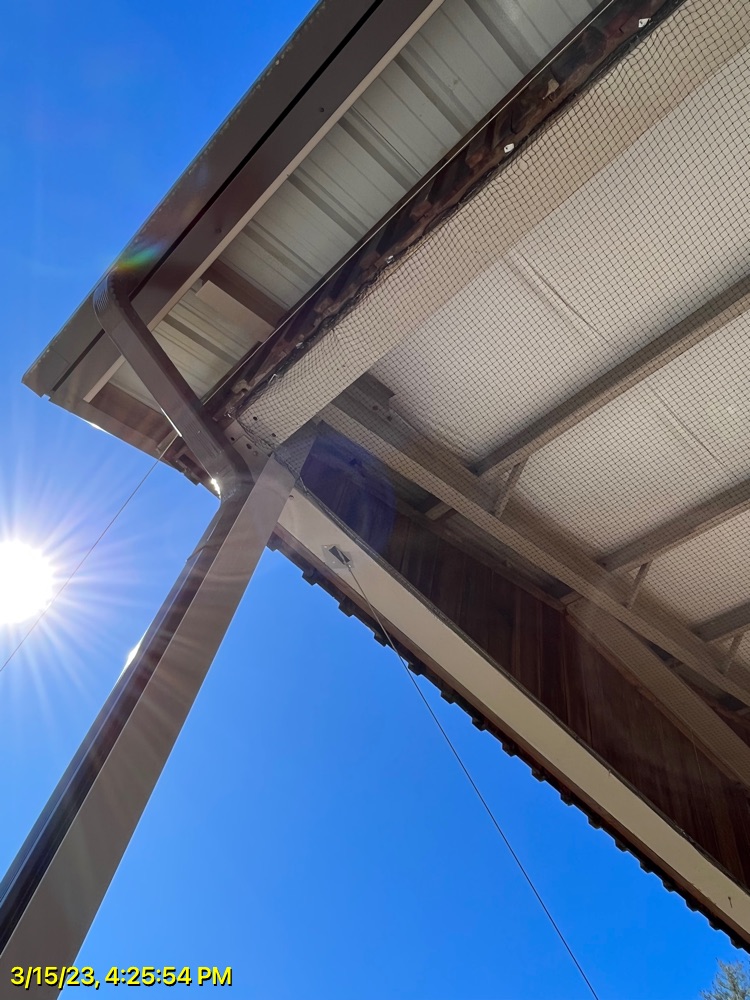
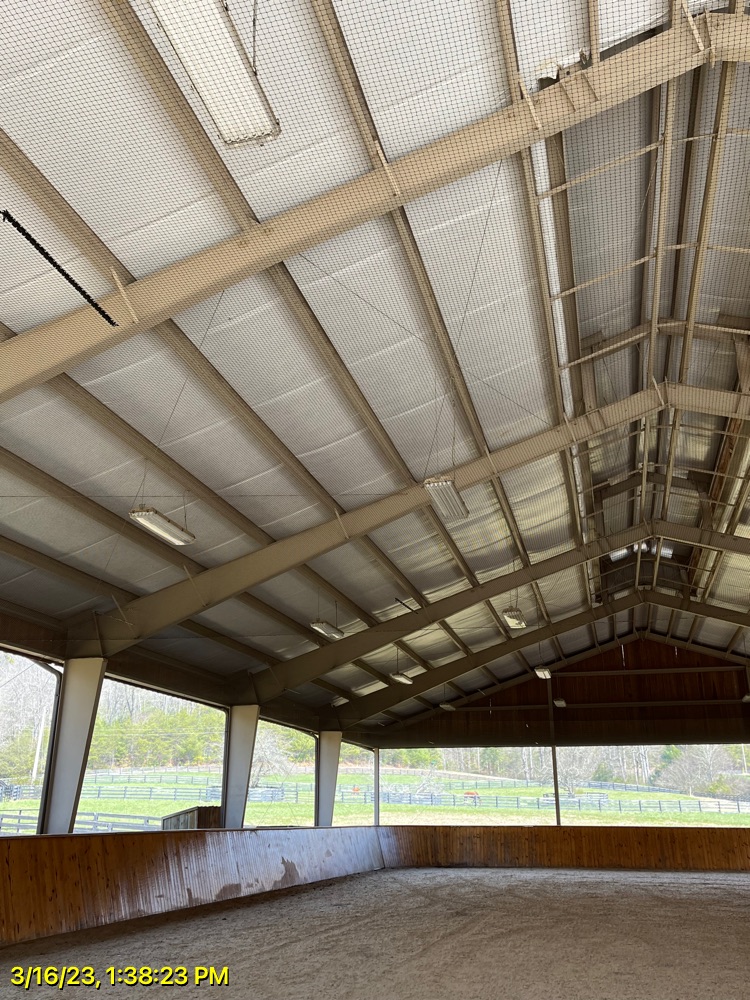






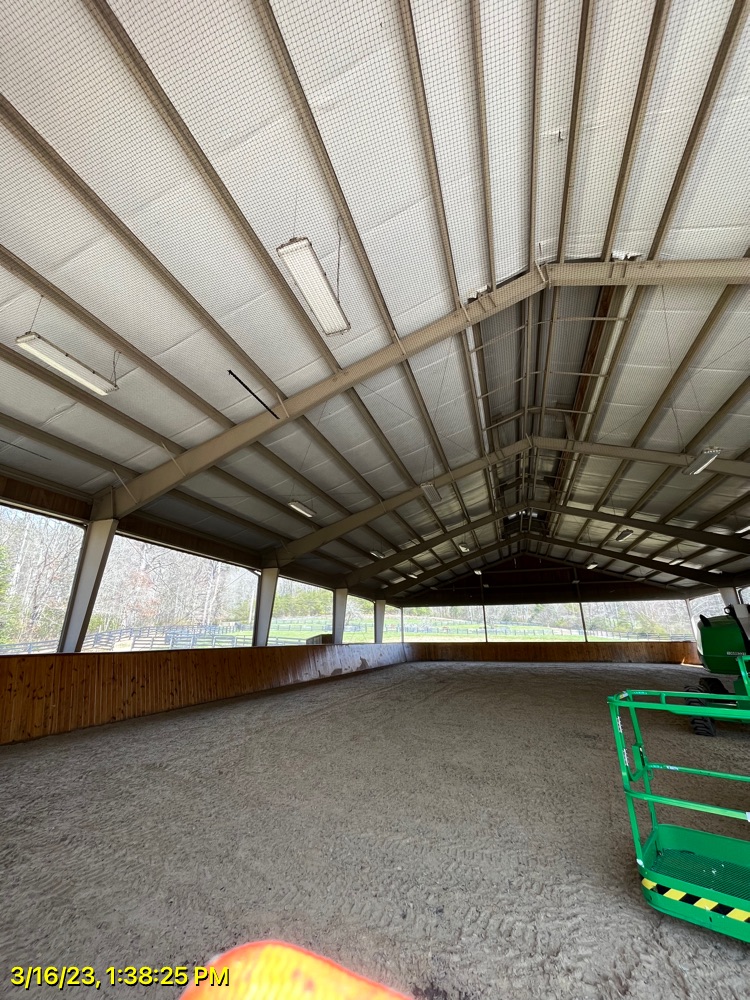


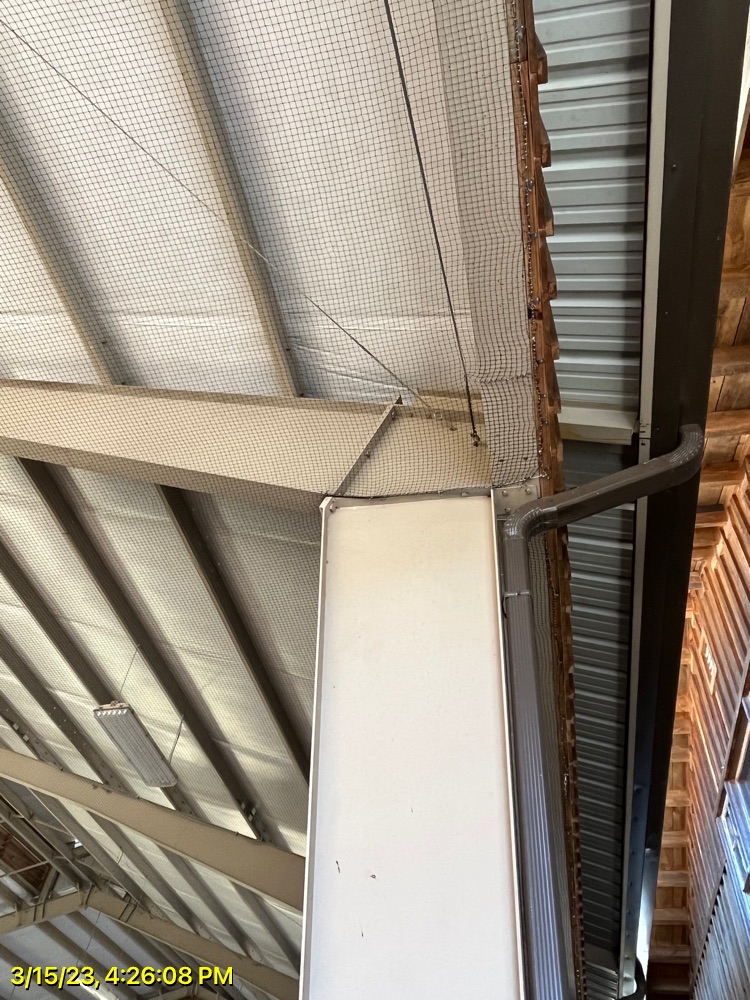

Problems from Barn Swallow
Mess and Noise: Barn swallows build their nests out of mud, which they often affix to vertical surfaces like the undersides of eaves, bridges, or the insides of barns and sheds. The accumulation of mud and bird droppings can create unsightly messes and unpleasant odors. Additionally, the birds can be quite vocal, especially during the breeding season, which may be disruptive in urban or residential areas.
Structural Damage: The acidic nature of barn swallow droppings can potentially corrode and damage building materials over time. Their nests can also clog drainage systems and cause water damage.
Health Concerns: Accumulated bird droppings can harbor bacteria, fungi, and parasites, posing health risks to humans, especially if the droppings are in areas where people frequent or where food is prepared or consumed.
Legal Issues: In some cases, the presence of barn swallow nests on structures can raise legal concerns, especially if the structures are designated as historic or protected.
Photos and information provided by Critter Control of Greenville, SC